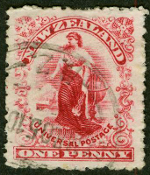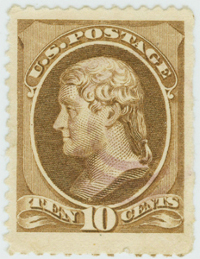
Discussion - Member to Member Sales - Research Center

Discussion - Member to Member Sales - Research Center

This post happens to be about an apparent unlisted postal stationery paper color. The image below shows three copies of what might be considered a paper color variant of either Scott U163, the 3-cent green Washington indicium on white paper, or U164 on amber paper. All three copies are on laid paper and each includes a portion of a watermark. The watermark on the left-hand copy is UPSS watermark 2; the middle copy may be watermark 2 as well and the right-hand copy watermark has not been determined. All three are postmarked 1882. The best candidate city for originating post office for all three is Chicago. According to a 1910 railways guide, Chicago was located 211 railway miles northwest of Union City.
The image also shows the back sides of these three cut squares along with samples of amber, bright white and ordinary white papers. The six cut square backs were all scanned together in one pass to eliminate the possibility of introducing any processing differences in the colors.
My ©2012 United Postal Stationery Society (UPSS) catalog identifies these three cut squares as Die 57. The catalog includes a few Die 56 sub-listings for the similar 3-cent green indicium on both white (Scott U159) and amber (Scott 160) paper. The catalog does not list any paper color varieties for Die 57 white paper, but lists two “pale amber” paper varieties among the amber paper listings. For Die 57, the variety listings for white and amber papers are lengthy, but neither includes any paper color variations. The UPSS catalog includes the following paragraph in the “Amber Paper (1863-to 1944)” section on pages 4-5.
“Shades exist with only slight traces of yellow. There is a very pale amber which is frequently mistaken for creamy white (as on the 7c Stanton UPSS 222a). This paper is thin, shows only very faint traces of yellow and when examined without any white paper for comparison, might easily be mistaken for white paper. Differences are also particularly noticeable on the 3c Plimpton War Department envelopes having been made from this amber paper and designated as 3rd quality.”
The image I am displaying here appears to me to show the faces of the three cut squares in question to be lighter than the backs of the stamps. I initially thought the difference was related to my scanning, but I now think this is an illusion. To test that theory, I opened the image in Photoshop and copied swatches from the cut square faces without any of the indicium and without any of the paper edges. I then dragged those swatches over the displayed backs of the three cut squares in that same image to compare the colors. It is surprising how our eyes can be fooled into seeing differences that don’t exist or are exaggerated. I am guessing the illusion is due to the presence of the darker indicia on the cut square faces adjacent to the areas of blank paper.
Comments are welcome!
Tom


Login to Like
this post

Yes, here I go again. Another post about the cut square hoard I inherited from Dad nearly 20 years ago. It consists of 11-12,000 cut squares collected in Union City, Indiana, mostly between 1891 and 1893. The large accumulation of cut squares presents me with a unique and fascinating view of local and national commerce in that period, as well as an introduction to U.S. postal stationery. Since I hadn’t collected U.S. or, for that matter, used stamps since I was a kid, I knew nothing about postal stationery or cancellations (especially fancy and geometric cancels) or postal history in general. This became a long-term learning experience.
This post happens to be about an apparent unlisted postal stationery paper color. The image below shows three copies of what might be considered a paper color variant of either Scott U163, the 3-cent green Washington indicium on white paper, or U164 on amber paper. All three copies are on laid paper and each includes a portion of a watermark. The watermark on the left-hand copy is UPSS watermark 2; the middle copy may be watermark 2 as well and the right-hand copy watermark has not been determined. All three are postmarked 1882. The best candidate city for originating post office for all three is Chicago. According to a 1910 railways guide, Chicago was located 211 railway miles northwest of Union City.
The image also shows the back sides of these three cut squares along with samples of amber, bright white and ordinary white papers. The six cut square backs were all scanned together in one pass to eliminate the possibility of introducing any processing differences in the colors.
My ©2012 United Postal Stationery Society (UPSS) catalog identifies these three cut squares as Die 57. The catalog includes a few Die 56 sub-listings for the similar 3-cent green indicium on both white (Scott U159) and amber (Scott 160) paper. The catalog does not list any paper color varieties for Die 57 white paper, but lists two “pale amber” paper varieties among the amber paper listings. For Die 57, the variety listings for white and amber papers are lengthy, but neither includes any paper color variations. The UPSS catalog includes the following paragraph in the “Amber Paper (1863-to 1944)” section on pages 4-5.
“Shades exist with only slight traces of yellow. There is a very pale amber which is frequently mistaken for creamy white (as on the 7c Stanton UPSS 222a). This paper is thin, shows only very faint traces of yellow and when examined without any white paper for comparison, might easily be mistaken for white paper. Differences are also particularly noticeable on the 3c Plimpton War Department envelopes having been made from this amber paper and designated as 3rd quality.”
The image I am displaying here appears to me to show the faces of the three cut squares in question to be lighter than the backs of the stamps. I initially thought the difference was related to my scanning, but I now think this is an illusion. To test that theory, I opened the image in Photoshop and copied swatches from the cut square faces without any of the indicium and without any of the paper edges. I then dragged those swatches over the displayed backs of the three cut squares in that same image to compare the colors. It is surprising how our eyes can be fooled into seeing differences that don’t exist or are exaggerated. I am guessing the illusion is due to the presence of the darker indicia on the cut square faces adjacent to the areas of blank paper.
Comments are welcome!
Tom


Login to Like
this post

